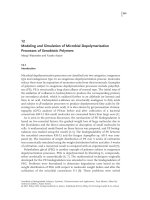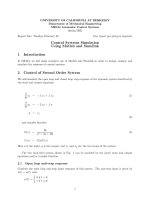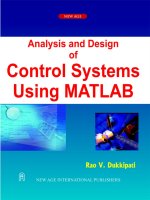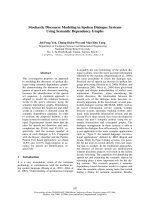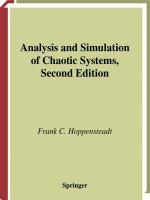modeling and simulation of systems using matlab and simulink
Bạn đang xem bản rút gọn của tài liệu. Xem và tải ngay bản đầy đủ của tài liệu tại đây (14.98 MB, 734 trang )
͂
͂
This page intentionally left blank
͂
͂
Ǥ
MATLAB ® and Simulink ® are trademarks of the MathWorks, Inc. and are used with permission. The MathWorks does
not warrant the accuracy of the text or exercises in this book. This book’s use or discussion of MATLAB ® and Simulink ®
software or related products does not constitute endorsement or sponsorship by the MathWorks of a particular pedagogi-
cal approach or particular use of the MATLAB ® and Simulink ® software.
CRC Press
Taylor & Francis Group
6000 Broken Sound Parkway NW, Suite 300
Boca Raton, FL 33487-2742
© 2010 by Taylor and Francis Group, LLC
CRC Press is an imprint of Taylor & Francis Group, an Informa business
No claim to original U.S. Government works
Printed in the United States of America on acid-free paper
10 9 8 7 6 5 4 3 2 1
International Standard Book Number: 978-1-4398-0672-2 (Hardback)
This book contains information obtained from authentic and highly regarded sources. Reasonable efforts have been
made to publish reliable data and information, but the author and publisher cannot assume responsibility for the valid-
ity of all materials or the consequences of their use. The authors and publishers have attempted to trace the copyright
holders of all material reproduced in this publication and apologize to copyright holders if permission to publish in this
form has not been obtained. If any copyright material has not been acknowledged please write and let us know so we may
rectify in any future reprint.
Except as permitted under U.S. Copyright Law, no part of this book may be reprinted, reproduced, transmitted, or uti-
lized in any form by any electronic, mechanical, or other means, now known or hereafter invented, including photocopy-
ing, microfilming, and recording, or in any information storage or retrieval system, without written permission from the
publishers.
For permission to photocopy or use material electronically from this work, please access www.copyright.com (http://
www.copyright.com/) or contact the Copyright Clearance Center, Inc. (CCC), 222 Rosewood Drive, Danvers, MA 01923,
978-750-8400. CCC is a not-for-profit organization that provides licenses and registration for a variety of users. For
organizations that have been granted a photocopy license by the CCC, a separate system of payment has been arranged.
Trademark Notice: Product or corporate names may be trademarks or registered trademarks, and are used only for
identification and explanation without intent to infringe.
Visit the Taylor & Francis Web site at
and the CRC Press Web site at
Dedicated to
The cherished memories of my guru and guide
Most Revered Dr. Makund Behari Lal Sahab
DSc (Lucknow), DSc (Edinburgh)
(1907–2002)
August Founder of Dayalbagh Educational Institute
This page intentionally left blank
vii
Contents
Preface xvii
Acknowledgments xxi
Author xxiii
1. Introduction to Systems 1
1.1 System 1
1.1.1 System Boundary 3
1.1.2 System Components and Their Interactions 3
1.1.3 Environment 4
1.2 Classi cation of Systems 5
1.2.1 According to the Time Frame 5
1.2.2 According to the Complexity of the System 6
1.2.3 According to the Interactions 6
1.2.4 According to the Nature and Type of Components 7
1.2.5 According to the Uncertainties Involved 7
1.2.5.1 Static vs. Dynamic Systems 8
1.2.5.2 Linear vs. Nonlinear Systems 8
1.3 Linear Systems 9
1.3.1 Superposition Theorem 9
1.3.2 Homogeneity 10
1.3.3 Mathematical Viewpoint of a Linear System 10
1.3.3.1 Linear Differential Equation 10
1.3.3.2 Nonlinear Differential Equations 11
1.4 Time-Varying vs. Time-Invariant Systems 12
1.5 Lumped vs. Distributed Parameter Systems 13
1.6 Continuous-Time and Discrete-Time Systems 13
1.7 Deterministic vs. Stochastic Systems 15
1.7.1 Complexity of Systems 15
1.8 Hard and Soft Systems 16
1.9 Analysis of Systems 18
1.10 Synthesis of Systems 18
1.11 Introduction to System Philosophy 18
1.11.1 Method of Science 20
1.11.1.1 Reductionism 20
1.11.1.2 Repeatability 20
1.11.1.3 Refutation 20
1.11.2 Problems of Science and Emergence of System 20
1.12 System Thinking 21
1.13 Large and Complex Applied System Engineering:
A Generic Modeling 24
1.14 Review Questions 29
1.15 Bibliographical Notes 30
viii Contents
2. Systems Modeling 31
2.1 Introduction 31
2.2 Need of System Modeling 33
2.3 Modeling Methods for Complex Systems 34
2.4 Classi cation of Models 35
2.4.1 Physical vs. Abstract Model 35
2.4.2 Mathematical vs. Descriptive Model 36
2.4.3 Static vs. Dynamic Model 37
2.4.4 Steady State vs. Transient Model 37
2.4.5 Open vs. Feedback Model 37
2.4.6 Deterministic vs. Stochastic Models 37
2.4.7 Continuous vs. Discrete Models 37
2.5 Characteristics of Models 38
2.6 Modeling 38
2.6.1 Fundamental Axiom (Modeling Hypothesis) 40
2.6.2 Component Postulate (First Postulate) 40
2.6.3 Model Evaluation 41
2.6.4 Generic Description of Two-Terminal
Components 41
2.6.4.1 Dissipater Type Components 41
2.6.4.2 Delay Type Elements 42
2.6.4.3 Accumulator Type 42
2.6.4.4 Sources or Drivers 43
2.7 Mathematical Modeling of Physical Systems 43
2.7.1 Modeling of Mechanical Systems 46
2.7.1.1 Translational Mechanical Systems 47
2.7.1.2 Rotational Mechanical Systems 64
2.7.2 Modeling of Electrical Systems 78
2.7.3 Modeling of Electromechanical Systems 84
2.7.4 Modeling of Fluid Systems 87
2.7.4.1 Hydraulic Systems 87
2.7.5 Modeling of Thermal Systems 92
2.8 Review Questions 99
2.9 Bibliographical Notes 102
3. Formulation of State Space Model of Systems 103
3.1 Physical Systems Theory 103
3.2 System Components and Interconnections 103
3.3 Computation of Parameters of a Component 105
3.4 Single Port and Multiport Systems 109
3.4.1 Linear Perfect Couplers 110
3.4.2 Summary of Two-Terminal and Multiterminal
Components 113
3.4.3 Multiterminal Components 113
3.5 Techniques of System Analysis 114
3.5.1 Lagrangian Technique 115
3.5.2 Free Body Diagram Method 115
3.5.3 Linear Graph Theoretic Approach 115
3.6 Basics of Linear Graph Theoretic Approach 116
Contents ix
3.7 Formulation of System Model for Conceptual System 119
3.7.1 Fundamental Axioms 121
3.7.2 Component Postulate 121
3.7.3 System Postulate 121
3.7.3.1 Cutset Postulate 122
3.7.3.2 Circuit Postulate 124
3.8 Formulation of System Model for Physical Systems 127
3.9 Topological Restrictions 131
3.9.1 Perfect Coupler 131
3.9.2 Gyrator 131
3.9.3 Short Circuit Element (“A” Type) 132
3.9.4 Open Circuit Element (“B” Type) 132
3.9.5 Dissipater Type Elements 132
3.9.6 Delay Type Elements 132
3.9.7 Accumulator Type Elements 132
3.9.8 Across Drivers 133
3.9.9 Through Drivers 133
3.10 Development of State Model of Degenerative System 144
3.10.1 Development of State Model for Degenerate System 146
3.10.2 Symbolic Formulation of State Model for Nondegenerative
Systems 151
3.10.3 State Model of System with Multiterminal Components 157
3.10.4 State Model for Systems with Time Varying and Nonlinear
Components 162
3.11 Solution of State Equations 166
3.12 Controllability 180
3.13 Observability 181
3.14 Sensitivity 182
3.15 Liapunov Stability 184
3.16 Performance Characteristics of Linear Time Invariant Systems 186
3.17 Formulation of State Space Model Using Computer Program (SYSMO) 187
3.17.1 Preparation of the Input Data 187
3.17.2 Algorithm for the Formulation of State Equations 187
3.18 Review Questions 208
3.19 Bibliographical Notes 217
4. Model Order Reduction 219
4.1 Introduction 219
4.2 Difference between Model Simpli cation and Model Order Reduction 220
4.3 Need for Model Order Reduction 221
4.4 Principle of Model Order Reduction 221
4.5 Methods of Model Order Reduction 223
4.5.1 Time Domain Simpli cation Techniques 223
4.5.1.1 Dominant Eigenvalue Approach 223
4.5.1.2 Aggregation Method 228
4.5.1.3 Subspace Projection Method 232
4.5.1.4 Optimal Order Reduction 233
4.5.1.5 Hankel Matrix Approach 233
4.5.1.6 Hankel–Norm Model Order Reduction 234
x Contents
4.5.2 Model Order Reduction in Frequency Domain 234
4.5.2.1 Pade Approximation Method 234
4.5.2.2 Continued Fraction Expansion 235
4.5.2.3 Moment-Matching Method 235
4.5.2.4 Balanced Realization-Based Reduction Method 236
4.5.2.5 Balanced Truncation 238
4.5.2.6 Frequency-Weighted Balanced Model Reduction 244
4.5.2.7 Time Moment Matching 249
4.5.2.8 Continued Fraction Expansion 252
4.5.2.9 Model Order Reduction Based on the Routh
Stability Criterion 259
4.5.2.10 Differentiation Method for Model Order
Reduction 263
4.6 Applications of Reduced-Order Models 273
4.7 Review Questions 273
4.8 Bibliographical Notes 275
5. Analogous of Linear Systems 277
5.1 Introduction 277
5.1.1 D’Alembert’s Principle 277
5.2 Force–Voltage (f–v) Analogy 278
5.2.1 Rule for Drawing f–v Analogous Electrical Circuits 278
5.3 Force–Current (f–i) Analogy 279
5.3.1 Rule for Drawing f–i Analogous Electrical Circuits 279
5.4 Review Questions 298
6. Interpretive Structural Modeling 301
6.1 Introduction 301
6.2 Graph Theory 301
6.2.1 Net 305
6.2.2 Loop 305
6.2.3 Cycle 305
6.2.4 Parallel Lines 306
6.2.5 Properties of Relations 306
6.3 Interpretive Structural Modeling 307
6.4 Review Questions 323
6.5 Bibliographical Notes 325
7. System Dynamics Techniques 327
7.1 Introduction 327
7.2 System Dynamics of Managerial and Socioeconomic System 327
7.2.1 Counterintuitive Nature of System Dynamics 327
7.2.2 Nonlinearity 328
7.2.3 Dynamics 328
7.2.4 Causality 328
7.2.5 Endogenous Behavior 328
7.3 Traditional Management 328
7.3.1 Strength of the Human Mind 328
7.3.2 Limitation of the Human Mind 328
Contents xi
7.4 Sources of Information 329
7.4.1 Mental Database 329
7.4.2 Written/Spoken Database 330
7.4.3 Numerical Database 330
7.5 Strength of System Dynamics 331
7.6 Experimental Approach to System Analysis 332
7.7 System Dynamics Technique 332
7.8 Structure of a System Dynamic Model 333
7.9 Basic Structure of System Dynamics Models 334
7.9.1 Level Variables 334
7.9.2 Flow-Rate Variables 334
7.9.3 Decision Function 335
7.10 Different Types of Equations Used in System Dynamics Techniques 342
7.10.1 Level Equation 342
7.10.2 Rate Equation (Decision Functions) 343
7.10.3 Auxiliary Equations 343
7.11 Symbol Used in Flow Diagrams 344
7.11.1 Levels 344
7.11.2 Source and Sinks 345
7.11.3 Information Takeoff 345
7.11.4 Auxiliary Variables 345
7.11.5 Parameters (Constants) 345
7.12 Dynamo Equations 345
7.13 Modeling and Simulation of Parachute Deceleration Device 376
7.13.1 Parachute In ation 377
7.13.2 Canopy Stress Distribution 378
7.13.3 Modeling and Simulation of Parachute Trajectory 378
7.14 Modeling of Heat Generated in a Parachute during Deployment 382
7.14.1 Dynamo Equations 384
7.15 Modeling of Stanchion System of Aircraft Arrester Barrier System 385
7.15.1 Modeling and Simulation of Forces Acting on Stanchion
System Using System Dynamic Technique 387
7.15.2 Dynamic Model 389
7.15.3 Results 390
7.16 Review Questions 395
7.17 Bibliographical Notes 399
8. Simulation 401
8.1 Introduction 401
8.2 Advantages of Simulation 402
8.3 When to Use Simulations 403
8.4 Simulation Provides 403
8.5 How Simulations Improve Analysis and Decision Making? 404
8.6 Application of Simulation 404
8.7 Numerical Methods for Simulation 405
8.7.1 The Rectangle Rule 406
8.7.2 The Trapezoid and Tangent Formulae 406
8.7.3 Simpson’s Rule 407
8.7.4 One-Step Euler’s Method 410
xii Contents
8.7.5 Runge–Kutta Methods of Integration 410
8.7.5.1 Physical Interpretation 411
8.7.6 Runge–Kutta Fourth-Order Method 411
8.7.7 Adams–Bashforth Predictor Method 412
8.7.8 Adams–Moulton Corrector Method 413
8.8 The Characteristics of Numerical Methods 413
8.9 Comparison of Different Numerical Methods 413
8.10 Errors during Simulation with Numerical Methods 414
8.10.1 Truncation Error 414
8.10.2 Round Off Error 415
8.10.3 Step Size vs. Error 418
8.10.4 Discretization Error 418
8.11 Review Questions 430
9. Nonlinear and Chaotic System 433
9.1 Introduction 433
9.2 Linear vs. Nonlinear System 434
9.3 Types of Nonlinearities 434
9.4 Nonlinearities in Flight Control of Aircraft 435
9.4.1 Basic Control Surfaces Used in Aircraft Maneuvers 435
9.4.2 Principle of Flight Controls 435
9.4.3 Components Used in Pitch Control 437
9.4.4 Modeling of Various Components of Pitch Control System 438
9.4.5 Simulink Model of Pitch Control in Flight 440
9.4.5.1 Simulink Model of Pitch Control in Flight Using
Nonlinearities 440
9.4.6 Study of Effects of Different Nonlinearities on Behavior
of the Pitch Control Model 440
9.4.6.1 Effects of Dead-Zone Nonlinearities 440
9.4.6.2 Effects of Saturation Nonlinearities 441
9.4.6.3 Effects of Backlash Nonlinearities 442
9.4.6.4 Cumulative Effects of Backlash, Saturation, Dead-Zone
Nonlinearities 443
9.4.7 Designing a PID Controller for Pitch Control in Flight 445
9.4.7.1 Designing a PID Controller for Pitch Control in Flight
with the Help of Root Locus Method
(Feedback Compensation) 445
9.4.7.2 Designing a PID Controller (Connected in Cascade
with the System) for Pitch Control in Flight 454
9.4.7.3 Design of P, I, D, PD, PI, PID, and Fuzzy Controllers 456
9.4.8 Design of Fuzzy Controller 461
9.4.8.1 Basic Structure of a Fuzzy Controller 462
9.4.8.2 The Components of a Fuzzy System 462
9.4.9 Tuning Fuzzy Controller 469
9.5 Conclusions 473
9.6 Introduction to Chaotic System 478
9.6.1 General Meaning 478
9.6.2 Scienti c Meaning 478
9.6.3 De nition 479
Contents xiii
9.7 Historical Prospective 481
9.8 First-Order Continuous-Time System 484
9.9 Bifurcations 487
9.9.1 Saddle Node Bifurcation 488
9.9.2 Transcritical Bifurcation 488
9.9.3 Pitchfork Bifurcation 490
9.9.3.1 Supercritical Pitchfork Bifurcation 490
9.9.4 Catastrophes 492
9.9.4.1 Globally Attracting Point for Stability 492
9.10 Second-Order System 493
9.11 Third-Order System 496
9.11.1 Lorenz Equation: A Chaotic Water Wheel 498
9.12 Review Questions 501
9.13 Bibliographical Notes 501
10. Modeling with Arti cial Neural Network 503
10.1 Introduction 503
10.1.1 Biological Neuron 503
10.1.2 Arti cial Neuron 504
10.2 Arti cial Neural Networks 505
10.2.1 Training Phase 505
10.2.1.1 Selection of Neuron Characteristics 505
10.2.1.2 Selection of Topology 505
10.2.1.3 Error Minimization Process 506
10.2.1.4 Selection of Training Pattern and Preprocessing 506
10.2.1.5 Stopping Criteria of Training 506
10.2.2 Testing Phase 506
10.2.2.1 ANN Model 506
10.2.2.2 Building ANN Model 508
10.2.2.3 Backpropagation 509
10.2.2.4 Training Algorithm 509
10.2.2.5 Applications of Neural Network Modeling 510
10.3 Review Questions 526
11. Modeling Using Fuzzy Systems 527
11.1 Introduction 527
11.2 Fuzzy Sets 528
11.3 Features of Fuzzy Sets 531
11.4 Operations on Fuzzy Sets 532
11.4.1 Fuzzy Intersection 532
11.4.2 Fuzzy Union 532
11.4.3 Fuzzy Complement 532
11.4.4 Fuzzy Concentration 533
11.4.5 Fuzzy Dilation 534
11.4.6 Fuzzy Intensi cation 535
11.4.7 Bounded Sum 536
11.4.8 Strong α-Cut 537
11.4.9 Linguistic Hedges 538
11.5 Characteristics of Fuzzy Sets 540
xiv Contents
11.5.1 Normal Fuzzy Set 540
11.5.2 Convex Fuzzy Set 540
11.5.3 Fuzzy Singleton 540
11.5.4 Cardinality 540
11.6 Properties of Fuzzy Sets 541
11.7 Fuzzy Cartesian Product 541
11.8 Fuzzy Relation 542
11.9 Approximate Reasoning 545
11.10 Defuzzi cation Methods 554
11.11 Introduction to Fuzzy Rule-Based Systems 556
11.12 Applications of Fuzzy Systems to System Modeling 558
11.12.1 Single Input Single Output Systems 559
11.12.2 Multiple Input Single Output Systems 564
11.12.3 Multiple Input Multiple Output Systems 566
11.13 Takagi–Sugeno–Kang Fuzzy Models 567
11.14 Adaptive Neuro-Fuzzy Inferencing Systems 568
11.15 Steady State DC Machine Model 574
11.16 Transient Model of a DC Machine 579
11.17 Fuzzy System Applications for Operations Research 592
11.18 Review Questions 602
11.19 Bibliography and Historical Notes 603
12. Discrete-Event Modeling and Simulation 605
12.1 Introduction 605
12.2 Some Important De nitions 606
12.3 Queuing System 609
12.4 Discrete-Event System Simulation 611
12.5 Components of Discrete-Event System Simulation 611
12.6 Input Data Modeling 615
12.7 Family of Distributions for Input Data 615
12.8 Random Number Generation 616
12.8.1 Uniform Distribution 616
12.8.2 Gaussian Distribution of Random Number
Generat ion 617
12.9 Chi-Square Test 619
12.10 Kolomogrov–Smirnov Test 619
12.11 Review Questions 619
Appendix A 621
A.1 What Is MATLAB
®
? 621
A.2 Learning MATLAB 621
A.3 The MATLAB System 621
A.3.1 Development Environment 622
A.3.2 The MATLAB Mathematical Function Library 622
A.3.3 The MATLAB Language 622
A.3.4 Handle Graphics 622
A.3.5 The MATLAB Application Program Interface (API) 623
A.4 Starting and Quitting MATLAB 623
A.5 MATLAB Desktop 623
Contents xv
A.6 Desktop Tools 623
A.6.1 Command Window 623
A.6.2 Command History 624
A.6.2.1 Running External Programs 624
A.6.2.2 Launch Pad 625
A.6.2.3 Help Browser 625
A.6.2.4 Current Directory Browser 626
A.6.2.5 Workspace Browser 626
A.6.2.6 Array Editor 626
A.6.2.7 Editor/Debugger 627
A.6.2.8 Other Development Environment Features 627
A.7 Entering Matrices 627
A.8 Subscripts 630
A.9 The Colon Operator 630
A.10 The Magic Function 631
A.11 Expressions 631
A.11.1 Variables 632
A.11.2 Numbers 632
A.11.3 Operators 632
A.11.4 Functions 632
A.11.4.1 Generating Matrices 633
A.12 The Load Command 633
A.13 The Format Command 635
A.14 Suppressing Output 635
A.15 Entering Long Command Lines 635
A.16 Basic Plotting 636
A.16.1 Creating a Plot 636
A.16.2 Multiple Data Sets in One Graph 636
A.16.3 Plotting Lines and Markers 636
A.16.4 Adding Plots to an Existing Graph 637
A.16.5 Multiple Plots in One Figure 637
A.16.6 Setting Grid Lines 638
A.16.7 Axis Labels and Titles 638
A.16.8 Saving a Figure 638
A.16.9 Mesh and Surface Plots 638
A.17 Images 640
A.18 Handle Graphics 640
A.18.1 Setting Properties from Plotting Commands 640
A.18.2 Different Types of Graphs 640
A.18.2.1 Bar and Area Graphs 641
A.19 Animations 644
A.20 Creating Movies 644
A.21 Flow Control 645
A.21.1 If 645
A.21.2 Switch and Case 646
A.21.2.1 For 646
A.21.2.2 While 647
A.21.2.3 Continue 647
A.21.2.4 Break 647
xvi Contents
A.22 Other Data Structures 648
A.22.1 Multidimensional Arrays 648
A.22.2 Cell Arrays 650
A.22.3 Characters and Text 650
A.23 Scripts and Functions 654
A.23.1 Scripts 654
A.23.2 Functions 655
A.23.2.1 Global Variables 655
A.23.2.2 Passing String Arguments to Functions 656
A.23.2.3 Constructing String Arguments in Code 656
A.23.2.4 A Cautionary Note 656
A.23.2.5 The Eval Function 657
A.23.2.6 Vectorization 657
A.23.2.7 Preallocation 658
A.23.2.8 Function Handles 658
A.23.2.9 Function Functions 658
Appendix B: Simulink 661
B.1 Introduction 661
B.2 Features of Simulink 661
B.3 Simulation Parameters and Solvers 661
B.4 Construction of Block Diagram 663
B.5 Review Questions 667
Appendix C: Glossary 671
C.1 Modeling and Simulation 671
C.2 Arti cial Neural Network 676
C.3 Fuzzy Systems 678
C.4 Genetic Algorithms 680
Bibliography 681
Index 693
xvii
Preface
Systems engineering has great potential for solving problems related to physical, concep-
tual, and esoteric systems. The power of systems engineering lies in the three R’s of science,
namely, reductionism, repeatability, and refutation. Reductionism recognizes the fact that
any system can be decomposed into a set of components that follow the fundamental laws of
physics. The diversity of the real world can be reduced into laboratory experiments, which
can be validated by their repeatability, and one can make intellectual progress by the refu-
tation of hypotheses. Due to advancements in systems engineering for handling complex
systems, modeling and simulation have, of late, become popular.
Modeling and simulation are very important tools of systems engineering that have
now become a central activity in all disciplines of engineering and science. Not only do
they help us gain a better understanding of the functioning of the real world, they are also
important for the design of new systems as they enable us to predict the system behavior
before the system is actually built. Modeling and simulation also allow us to analyze sys-
tems accurately under varying operating conditions.
This book aims to provide a comprehensive, state-of-the-art coverage of all important
aspects of modeling and simulation of physical as well as conceptual systems. It strives to
motivate beginners in this area through the modeling of real-life examples and their simu-
lation to gain better insights into real-world systems. The extensive references and related
literature at the end of every chapter can also be referred to for further studies in the area
of modeling and simulation.
This book aims to
Provide a basic understanding of systems and their modeling and simulation•
Explain the step-by-step procedure for modeling using top-down, bottom-up, and •
middle-out approaches
Develop models for complex systems and reduce their order so as to use them •
effectively for online applications
Present the simulation code in MATLAB•
®
/Simulink
®
for gaining quick and useful
insights into real-world systems
Apply soft computing techniques for modeling nonlinear, ill-de ned, and com-•
plex systems
The book will serve as a primary text for a variety of courses. It can be used as a rst course
in modeling and simulation at the junior, the senior, or the graduate levels in engineering,
manufacturing, business, or computer science (Chapters 1 through 3, 5, and 8), providing a
broad idea about modeling and simulation. At the end of such a course, the student would
be prepared to carry out complete and effective simulation studies, and to take advanced
modeling and simulation courses.
This book will also serve as a second course for more advanced studies in modeling and
simulation for graduate students (Chapters 6 through 11) in any of the above disciplines.
After completing this course, the student should be able to comprehend and conduct simu-
lation research.
xviii Preface
Finally, this book will serve as an introduction to simulation as part of a general course
in operations research or management science (Chapters 1 through 3 and 6 through 8,
Chapter 12).
Organization of the Book
Early chapters deal with the introduction of systems and includes concepts and their
underlying philosophy; step-by-step procedures for the modeling of different types of
systems using appropriate modeling techniques such as the graph-theoretic approach,
interpretive structural modeling, and system dynamics modeling, are also discussed.
Focus then moves to the state of the art of simulation and how simulation evolved from
the pre-computer days into the modern science of today. In this part, MATLAB/Simulink
programs are developed for system simulation.
FIGURE P1
Schematic outline of the book.
Analysis
Simulation using
MATLAB/Simulink
(Chapter 8)
Model order
reduction
(Chapter 4)
System dynamics
technique
(Chapter 7)
Soft computing
technique
(Chapters 10 and 11)
State space model
using graph theoretic
approach
(Chapter 3)
Nonlinear and chaotic
systems
(Chapter 9)
Interpretive structural
modeling (Chapter 6)
System
Chapters 1 and 5
Modeling
concepts
(Chapter 2)
Discrete event systems
(Chapter 12)
Preface xix
We then take a fresh look at modern soft computing techniques (such as arti cial neural
networks [ANN], fuzzy systems, and genetic algorithms, or their combinations) for the
modeling and simulation of complex and nonlinear systems.
Finally, chapters address the discrete systems modeling. The schematic outline of this
book is shown in Figure P1.
Software Background
The key to the successful application of modeling and simulation techniques depends on
the effective use of their software. For this, it is necessary that the student be familiar
with their fundamentals. In this book, MATLAB/Simulink programming software are
used. Appendix B provides some background information on MATLAB/Simulink. The
MATLAB programs included in this book are easier to understand than the programs
written in other programming languages such as C/C++.
MATLAB
®
is a registered trademark of The MathWorks, Inc. For product information,
please contact:
The MathWorks, Inc.
3 Apple Hill Drive
Natick, MA 01760-2098 USA
Tel: 508 647 7000
Fax: 508-647-7001
E-mail:
Web: www.mathworks.com
This page intentionally left blank
xxi
Acknowledgments
I express my profound and grateful veneration to Prof. P. S. Satsangi, chairman,
advisory committee on education in the Dayalbagh Educational Institute, Agra, Uttar
Pradesh, India. Prof. Satsangi taught me modeling and simulation methodologies, and
software engineering at the postgraduate (MTech) level and guided me during my
MTech and PhD in the area of modeling and simulation. He is the fountain source of
my inspiration and intuition in this area. I thank him with due reverence. I am also
thankful to Prof. P. K. Kalra, Indian Institute of Technology, Kanpur, India, for the
encouragement, support, and visionary ideas he provided during my research. I am
very deeply indebted to Prof. O. P. Malik, University of Calgary, Alberta, Canada, for
providing all the facilities in his laboratory to pursue my experimental work on mod-
eling and control during my BOYSCAST (Better Opportunities for Young Scientists
in Chosen Areas of Science and Technology) fellowship, offered by the Department
of Science and Technology, Government of India, during 2001–2002, and, later, in the
summer of 2005 and 2007.
I wish to express my deep gratitude to Prof. Helmut Röck and Prof. Anand Srivastava,
Universitate Zu Kiel, Kiel, Germany, and to Prof. Chaudhary, Imperial College London,
United Kingdom, for providing all the facilities and help during my visit to these institu-
tions in the summer of 2007.
I would also like to thank Prof. Westwick and Garwin Hancock, University of Calgary,
Alberta, Canada; Prof. P.H. Roe, system design engineering, and Prof. Shesha Jayaram,
High Voltage Lab, University of Waterloo, Ontario, Canada; and S. Krishnananda at the
Dayalbagh Educational Institute, Agra, Uttar Pradesh, India, for their good wishes and
help extended during the preparation of this book. Thanks are also due to my colleagues
Anand Sinha, Gaurav Rana, Himanshu Vijay, and Ashish Chandiok for all their help.
I am thankful to Jessica Vakili and Amber Donley, project coordinators; Nora Konopka,
publisher of engineering and environmental science books; and other team members from
Taylor & Francis who directly or indirectly helped in realizing this book.
Finally, I am grateful to my wife, Dr. Lajwanti, and my daughters, Jyoti and Swati, who
had to endure many inconveniences during the course of writing this book.
I also express my deepest gratitude to many, not mentioned here, for their support in
countless ways when this book was written.
Devendra K. Chaturvedi
Dayalbagh Educational Institute (Deemed University)
Agra, Uttar Pradesh, India
This page intentionally left blank
xxiii
Author
Devendra K. Chaturvedi was born in Madhya Pradesh, India,
on August 3, 1967. He graduated in electrical engineering from
the Government Engineering College, Ujjain, Madhya Pradesh,
India in 1988, and did his MTech in engineering systems and
management in 1993. He then pursued his PhD in electrical
power systems in 1998 from the Dayalbagh Educational Institute
(Deemed University), Agra, India. Currently, he is working
as a professor in the Department of Electrical Engineering,
Dayalbagh Educational Institute (Deemed University). He has
won several awards and recognition including the President’s
Gold Medal and the Director’s Medal of the Dayalbagh Educational Institute (Deemed
University) in 1993, the Tata Rao Medal in 1994, the Dr. P. S. Nigam U.P. State Power Sector
Award in 2005 and 2007, the Musaddi Lal Memorial Award in 2007, and the institutional
prize award in 2005 from the Institution of Engineers, India. He was awarded a BOYSCAST
fellowship of the Department of Science and Technology, Government of India, in 2001.
He is a regular visiting fellow at the University of Calgary, Alberta, Canada. He has
many national and international research collaborations in the area of modeling and
simulations, soft computing, intelligent adaptive control systems, and optimization. He
has also organized many short-term courses in the area of modeling and simulation of
systems, and fuzzy systems and its applications. He serves as a consultant at the Aerial
Delivery Research and Development Establishment, Agra, and at the Defense Research
and Development Organisation (DRDO) lab, Government of India. He has organized
many national seminars and workshops on theology; ethics, values, and social service;
professional ethics; ethics, agriculture, and religion; the relationship between religion and
the future of mankind; and the teachings of the Bhagavad Gita and the religions of saints.
He has authored a book, Soft Computing and Its Applications to Electrical Engineering,
published by Springer, Germany (2008). He has also edited a book, Theology, Science, and
Technology: Ethics and Moral Values, published by Vikas Publishing House, Delhi (2005).
His name is included in the Marquis Who’s Who in Engineering and Science in Asia (2006–
2007), the Marquis Who’s Who in Engineering and Science in America (2006–2007), and the
Marquis Who’s Who in World (2006–2007). He is a fellow of the Institution of Engineers,
India, and a member of many professional bodies such as the IEEE, the IEE, the Indian
Society for Technical Education (ISTE), the Indian Society of Continuing Engineering
Education (ISCEE), the Aeronautical Society of India, and the System Society of India.
This page intentionally left blank
